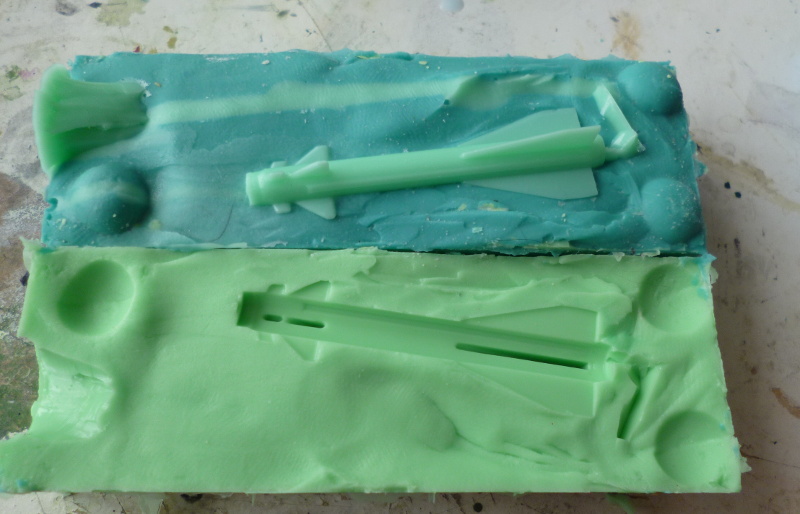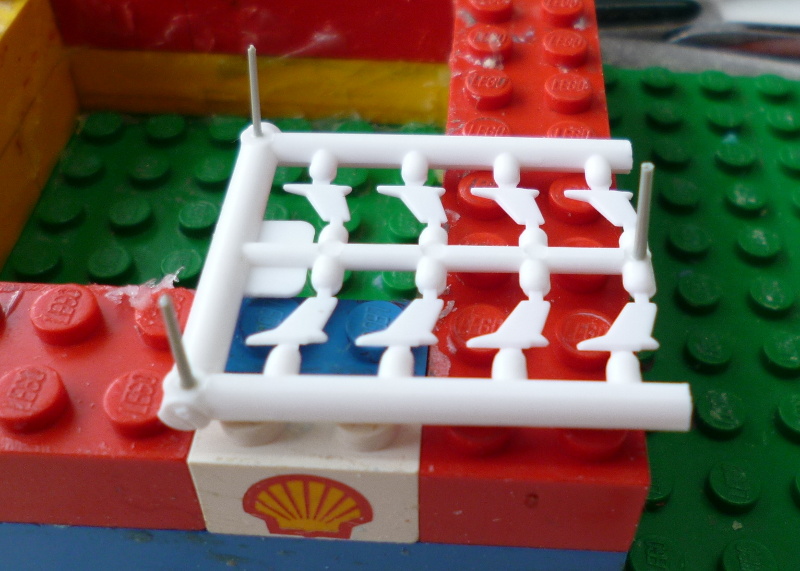Fair warning: I'll probably ramble...
I'll concentrate on casting resin parts in rubber moulds, but the general principles hold for all variations.
I'll completely ignore the part of creating a master to work from, but obviously you need some sort of good quality original part to start with. Scratch, steal, borrow, or buy as takes your fancy. The only thing that might have an impact on the process is that the master should, if at all possible, be able to withstand the mould making process.
Starting with the essentials, just what is a mould? Basically, anything with a correctly shaped cavity into which one can pour a liquid, wait for the liquid to become a solid, and remove the solidified result will do. The methods and materials used in making the mould are closely dependant on the material that will be cast into the mould. Resin, our primary focus here, is a very thin liquid that operates at room temperature, and which is capable of holding encredible detail, but once solidified, it is fragile. From this, it follows that our moulds must be impervious to the chemicals involved, able to capture a lot of detail, and be flexible enough to allow removal of the product without destroying it, but we need not worry about temperature tolerance. If we were to cast metal, flexibility would be less of an issue, but heat resistance would be critical. Another case would be casting super fine plaster, where chemical resistance would be mostly irrelevant, but flexibility of even greater importance (assuming fine and fragile parts). For resin, silicone rubber fits the bill. There are many types of silicone rubber, each with it's own strengths and weaknesses, but in general, this is the material of choise.
So, our mould will be a block of silicone rubber with a correctly shaped cavity in it. How do we accomplish this? The key here is that silicone rubber also starts out as a liquid, that sets into an, albeit rather flexible, solid, so in essence, we'll be casting our moulds. (Software engineers like me are total suckers for recursion
At this point I must take a sidestep to discuss mould design, since the design needs to be clear before we start pouring rubber into anything.
For simple items that have a flat side to them, a single piece mould will suffice. The opening through which the resin is poured in becomes the flat side, and the part is just squeezed out of the mould once the resin has set. This requires either a part with little or no undercuts, or very soft (=flexible) rubber, and it only works with parts where trapped air is unlikely to become a concern (trapped air could also be fixed by using a vacuum chamber, but that's hardly in scope for most of us; we'll have to think rather than brute force our way out of the issue). Note that vacform items are produced in such a mould, except that a sheet of plastic is sucked into the cavity, rather than the entire cavity being filled with some setting liquid. I might point out that making such a mould from a vacform sheet should be very easy, and for fidgitty parts might be a sensible alternative to sanding them out of a sheet.
More typical is a two piece mould, in which two closely fitting slabs of rubber surround the cavity. Another way to image this is a block of rubber with a cavity inside, cut in half so that the cut goes right through the cavity. Take a good look at injection moulded stuff from a tired old mould, and you'll see the seam in the form of flash. With the cavity completely enclosed inside the mould, it becomes necessary to connect the cavity to the outside world. Enter the sprue. I'll ramble on more about those later. There's also no reason to stop at two parts, although usually there's no reason to get more complicated. Remember that every cut through the mould is a possible leak.
Lets assume we need a two part mould.
There are two ways to go about creating one: suspend the part inside the box, pour the rubber around it, and cut open the mould with a sharp knife (this assumes you can still find the part in the block of rubber, and that you can do a neat cut without damaging the master inside), or pour the mould in two steps. In the latter case, something must take the part of the second half to be poured while the first half is being made. Soft plasticene clay is ideal for this.
Take a good look at the part, and build a low Lego wall (about a single block high, but sometimes more) around the part, leaving about 25mm margin on one side of the part (this will be the end from with you fill the mould later), about 10mm on the bottom, and at least 5mm on one side, and 10mm on the other (this is for resin, should you wish to make a mould for metal, you want larger side margins; resin leaking out the sides is messy, molten metal leaking out the sides is dangerous). Since Lego uses discrete steps, you might end up with bigger margings than absolutely necessary, but I tend to just accept that.
Now, remove the part from the Lego bucket just created, end fill the bucket to the brim with plasticene clay. Push the part into the clay until the part is embedded up to the point where you want the seam between the mould halves to be (not necessarily the middle of the piece, nor necessarily a straight line).
Look to injection moulded parts for guidance on where to place the seam. This may involve some rough sculpting of the plasticene to get it right. That's OK, in fact it helps. At some point you're going to have to close the mould halves, and it helps if the seam isn't completly straight. Even of there's no need for any plasticene sculpting, make some dents in it to serve as locator tabs for the mould halves later. Although not strictly necessary, this is also a good time to put a thin coat of mould release agent on the master (vaseline dissovled in white spirits will do nicely). Once this is done, start building up the Lego wall until the highest part of the piece is about 2cm below the top of the wall. Unless your Lego is branck spanking new, there will be gaps between the blocks. Rubber likes to try and escape through these creaks and settle in the cavities inside the blocks or on your workbench, which is not what you want. Rub something into the seams to prevent this (vaseline of plasticene are on hand at this stage, and work well enough, although not perfectly).
Calculate the volume of the open space inside the now enlagred Lego box. Disregard the volume taken up by the part; this compensates for the rubber that will be lost by cliging to your mixing vessel. Mix up the same volume of rubber, pour it in in such a way that the rubber rolls over the part like a wave (this helps prevent air pockets in the rubber forming contact with the part), and sit there tapping the mould with the rubber for about ten minutes. This is as boring as it gets, but the tapping helps any bubbles of air escape from the still liquid rubber, and we really want only one cavity inside that block. After you grow bored of tapping, leave it alone for a day.
The next day, disassemble the Lego wall, and peel away the plasticene. The part may come away with the plasticene, but will be easy to place back into the mould half. Put the part back into the rubber, and build another Lego wall around the block (the part is facing upwards at this point), plus once again 2cm extra height. Coat the first mould half plus the part in release agent (this time it is necessary), and pour on the second half.
The pictures below show situation after the first half is cast, after the second half, and a box of Lego still intact filled with rubber:
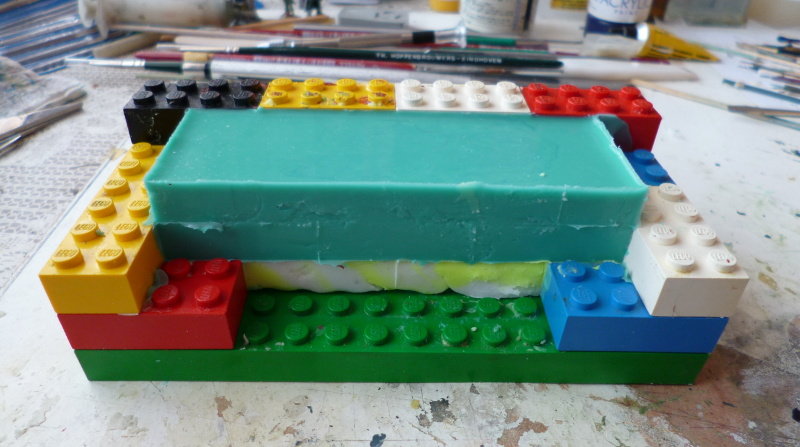
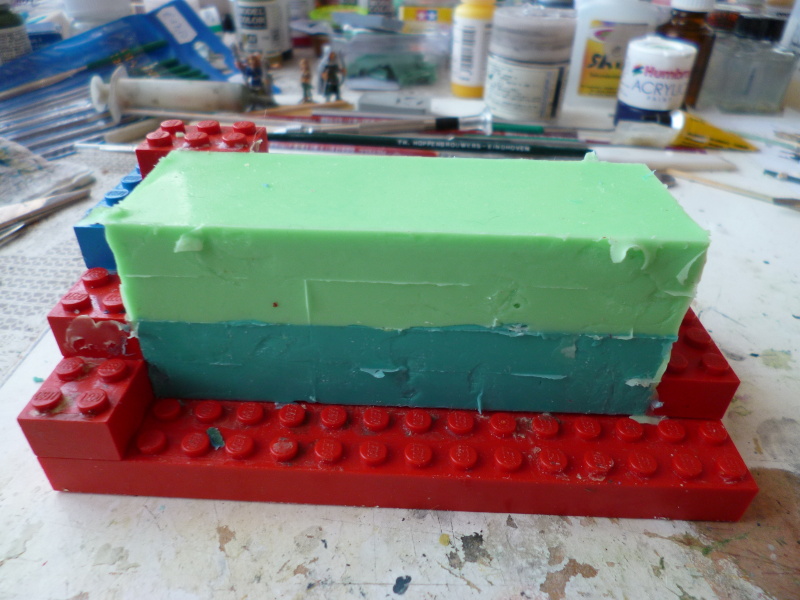
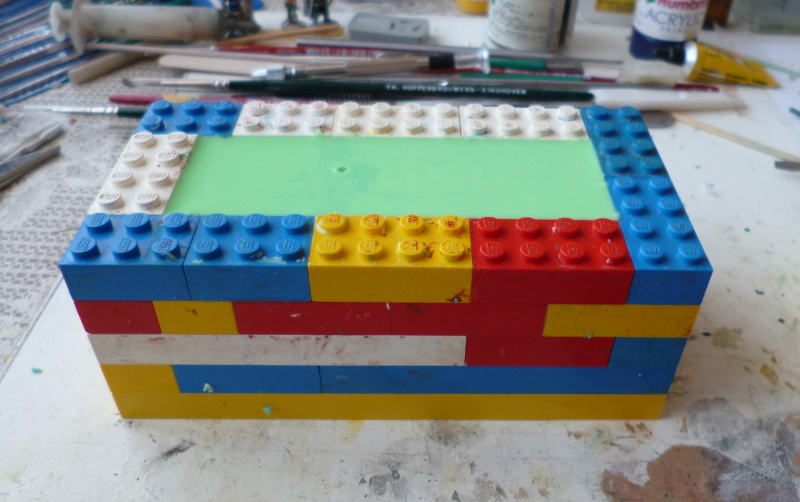
Now, we get back to sprues.
The purpose of a sprue is to provide an entry into the mould for the casting material. However, not all casting materials are equal.
When molten metal enters a narrow passage, it slows down, loses heat, solidifies and blocks up the passage. Thus, you want a relatively wide sprue and connection to the part, and as near as possible fill the mould from the central mass. This puts a nice big blob of hot metal behind anything settling into the fine detail. As a rule of the thumb, the sprue should extend half the height of the part above it, and come into the part cavity rought from above.
Resin behaves differently. It stays nice and runny, but tends to cling to the sides of the mould while filling it. This gives it the potential to cut off any exits before the air that fills the mould at the time of casting can escape. If the air can't get out, the resin can't take it's place, and the mould is not completely filled. The trick to work around this is to fill the mould from the bottom. Create the sprue as a column sitting beside the part (this is why one of the side margins needs to be wider), then a channel under the part, and finally the sprue gate entering the part from below.
Whatever the layout, the sprue needs to be cut into the mould halves with a sharp knife. Vents to allow the air out are also needed, but these can be much narrower. Keep in mind that regardless of the direction the vents take from the part cavity, they should always exit the mould at the top; otherwise they get to be called leaks, and will be used by your casting material to get out of the mould and onto you or your workbench.
The pictures below demonstrate these ideas.
The top one shows the original and first few casts from a resin mould. The "low" sprue and the air vent at the top of the part can be seen quite clearly.
The bottom picture shows two moulds for metal. The left one is for the body of a pilot figure, and is actually a three part mould: the bottom, in which a casting is seen lying face down, and the two top halves shown together with another casting lying on top. The sprue enters through the back of the figure, where the gate won't be seem through the seat he'll be mounted in. The logical separation between the mould halves would have put the sprue on head, feet or sides, neither of which was desirable, so I divided one of the halves again. The one on the right is more traditional for a metal mould, and is for the corresponding arms. The sprue and the locator tabs can clearly be seen. The white haze on these mould parts is talcum powder, which I dust onto the mould before casting to improve the flow and release characteristics.
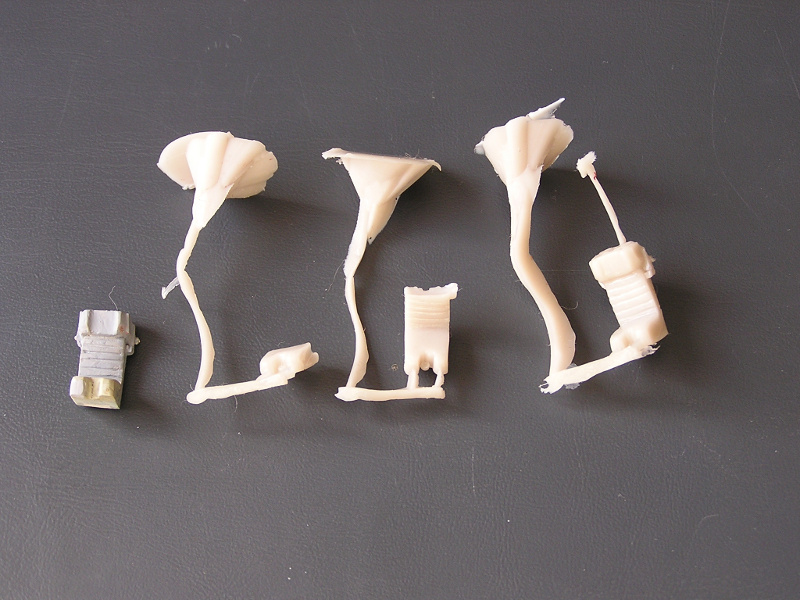
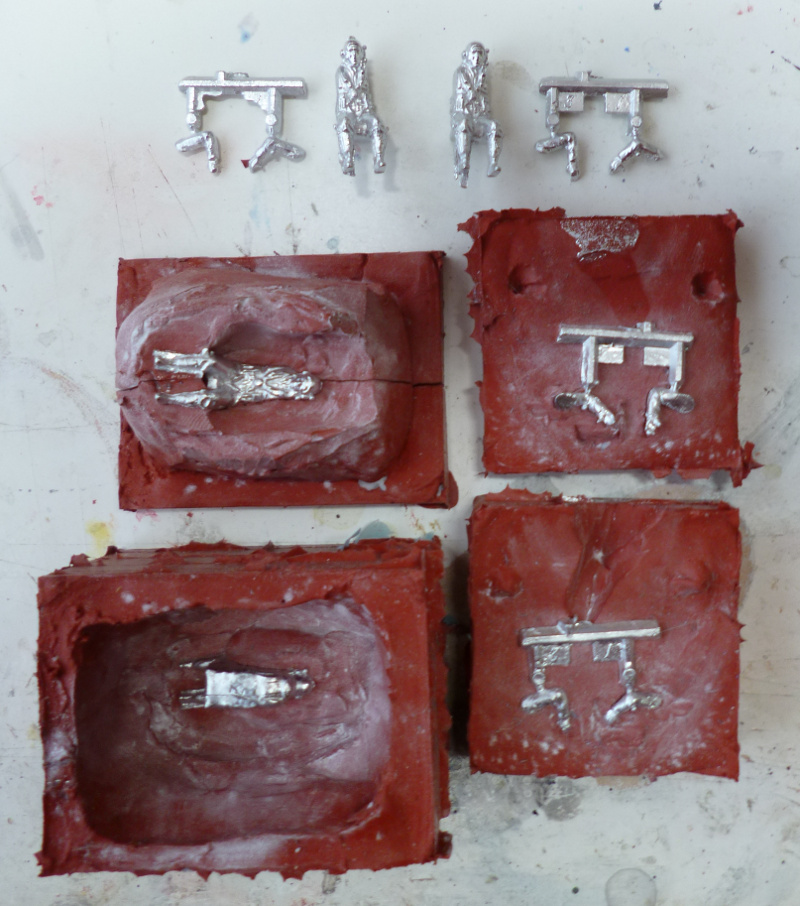
Right, over to you lot, I'm guaranteed to have missed some bits, so ask away.



